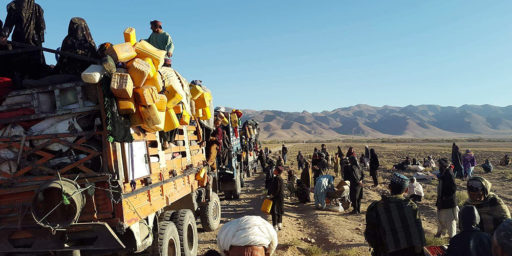Decision-Making for Afghanistan and Iraq
GEN Tommy Franks has an interesting op-ed in today’s NYT correcting what he believes is a distortion of the historical record of the Iraq War.
On more than one occasion, Senator Kerry has referred to the fight at Tora Bora in Afghanistan during late 2001 as a missed opportunity for America. He claims that our forces had Osama bin Laden cornered and allowed him to escape. How did it happen? According to Mr. Kerry, we “outsourced” the job to Afghan warlords. As commander of the allied forces in the Middle East, I was responsible for the operation at Tora Bora, and I can tell you that the senator’s understanding of events doesn’t square with reality.
First, take Mr. Kerry’s contention that we “had an opportunity to capture or kill Osama bin Laden” and that “we had him surrounded.” We don’t know to this day whether Mr. bin Laden was at Tora Bora in December 2001. Some intelligence sources said he was; others indicated he was in Pakistan at the time; still others suggested he was in Kashmir. Tora Bora was teeming with Taliban and Qaeda operatives, many of whom were killed or captured, but Mr. bin Laden was never within our grasp. Second, we did not “outsource” military action. We did rely heavily on Afghans because they knew Tora Bora, a mountainous, geographically difficult region on the border of Afghanistan and Pakistan. It is where Afghan mujahedeen holed up for years, keeping alive their resistance to the Soviet Union. Killing and capturing Taliban and Qaeda fighters was best done by the Afghan fighters who already knew the caves and tunnels. Third, the Afghans weren’t left to do the job alone. Special forces from the United States and several other countries were there, providing tactical leadership and calling in air strikes. Pakistani troops also provided significant help – as many as 100,000 sealed the border and rounded up hundreds of Qaeda and Taliban fighters.
Contrary to Senator Kerry, President Bush never “took his eye off the ball” when it came to Osama bin Laden. The war on terrorism has a global focus. It cannot be divided into separate and unrelated wars, one in Afghanistan and another in Iraq. Both are part of the same effort to capture and kill terrorists before they are able to strike America again, potentially with weapons of mass destruction. Terrorist cells are operating in some 60 countries, and the United States, in coordination with dozens of allies, is waging this war on many fronts.
Indeed, the fact that this charge continues to live is a testament to the utter naivete of large segments of the electorate. Even if one is a rabid Democratic partisan who believes Bush cared nothing about stopping terrorism, the idea that he would have passed up the huge PR boost of capturing bin Laden is absurd. Further, it presumes that the war was micro-managed from the Oval Office, something that hasn’t been done since the days of Lyndon Johnson.
Shifting to Iraq, Michael Gordon has an analysis piece in the same edition entitled, “The Strategy to Secure Iraq Did Not Foresee a 2nd War.” It’s one of those odd articles that doesn’t seem to be tied to any new event but that tries to synthesize previous stories. Gordon looks at the question of whether we could have avoided the insurgency in Iraq with better planning and, while not really coming to an answer, seems to suggest that we might have been able to do so had the right force mix been in place and certain assumptions not been underlying our concept of operation.
In the debate over the war and its aftermath, the Bush administration has portrayed the insurgency that is still roiling Iraq today as an unfortunate, and unavoidable, accident of history, an enemy that emerged only after melting away during the rapid American advance toward Baghdad. The sole mistake Mr. Bush has acknowledged in the war is in not foreseeing what he termed that “catastrophic success.” But many military officers and civilian officials who served in Iraq in the spring and summer of 2003 say the administration’s miscalculations cost the United States valuable momentum – and enabled an insurgency that was in its early phases to intensify and spread. “I think that there were Baathist Sunnis who planned to resist no matter what happened and at all cost, but we missed opportunities, and that drove more of them into the resistance,” Jay Garner, the first civilian administrator of Iraq and a retired Army lieutenant general, said in an interview, referring to the Baath Party of Mr. Hussein and to his Sunni Muslim supporters. “Things were stirred up far more than they should have been. We did not seal the borders because we did not have enough troops to do that, and that brought in terrorists.” A senior officer who served in Iraq but did not want to be identified because of the sensitivity of his position said: “The real question is, did there have to be an insurgency? Did we help create the insurgency by missing the window of opportunity in the period right after Saddam was removed from power?”
Looking back at that crucial time, those officers, administration officials and others provided an intimate and detailed account of how the postwar situation went awry. Civilian administrators of the Iraqi occupation raised concerns about plans to reduce American forces; intelligence agencies left American forces unprepared for the furious battles they encountered in Iraq’s southern cities and did not emphasize the risks of a postwar insurgency. And senior American generals and civilians were at odds over plans to build a new Iraqi army, which was needed to impose order.
These are fair points but it must be noted that in any complicated undertaking, many different views will be expressed. There is no indication given that there was a consensus on any of these things that was ignored. And, of course, we don’t know what the impact of having done these things would have been. Might they have minimized the insurgency? Perhaps. They might also have slowed down the military operations and created other problems.
The strategy was consistent with Defense Secretary Donald H. Rumsfeld’s push to transform the military so it would rely less on heavy ground troops and more on technology, intelligence and special operations forces. Mr. Rumsfeld had long been impatient with what he thought was a plodding, risk-averse and overly costly way of waging war. At General Franks’s Central Command, planners thought that the new approach was necessary for another reason: to catch the Iraqis by surprise and prevent any efforts to sabotage the oil fields or stiffen their Baghdad defenses. “Almost everybody worried about what would happen if the war were prolonged,” Douglas J. Feith, the under secretary of defense, said in an interview. “This highlighted the importance of speed and surprise. It argued for this unusual and creative way of starting the war, with fewer forces than Saddam expected us to have and to have the flow continue after the war started.” If the Iraqi Army mounted a tougher fight than anticipated, Mr. Feith said, the Pentagon could continue to send forces. If the resistance was light, as many civilian aides expected, Washington could stop the troop flow. There would be “off ramps,” in the vernacular of the Pentagon.
Achieving the administration’s ambitions meant dealing with any turmoil that followed the collapse of Mr. Hussein’s government and his iron-fisted security services. Administration officials assumed that American and multinational troops would help stabilize Iraq, but they also believed that the newly liberated Iraqis would share the burden. “The concept was that we would defeat the army, but the institutions would hold, everything from ministries to police forces,” Condoleezza Rice, the president’s national security adviser, said in an interview. “You would be able to bring new leadership but that we were going to keep the body in place.”
We clearly overestimated the willingness of ordinary Iraqis to join in the fight. The thinking was that, once Saddam was captured, they would lose their sense of fear and begin to take charge of their own lives. That didn’t happen to nearly the extent anticipated. Relying on a false assumption led to a critical error:
Thomas E. White, then the secretary of the Army, said he had received similar guidance from Mr. Rumsfeld’s office. “Our working budgetary assumption was that 90 days after completion of the operation, we would withdraw the first 50,000 and then every 30 days we’d take out another 50,000 until everybody was back,” he recalled. “The view was that whatever was left in Iraq would be de minimis.”
*** “The overall plan was to go get Saddam Hussein,” Colonel Apodaca recalled. “The assumption seemed to be that when people realized that he was gone, that would get the population on our side and facilitate the transition to reconstruction. We were not going to chase these guys when they ran to the smaller cities. We did not really have the force levels at that point to keep the insurgency down.”
The rationale behind this was logical enough: The longer U.S. troops were the face of the transition, the more resentment there would be. Having Iraqis and non-European faces on the reconstruction effort would have been preferable. Obviously, that turnover didn’t pan out. How it would have turned out had the U.S. had a larger force in place is, of course, an open question.




